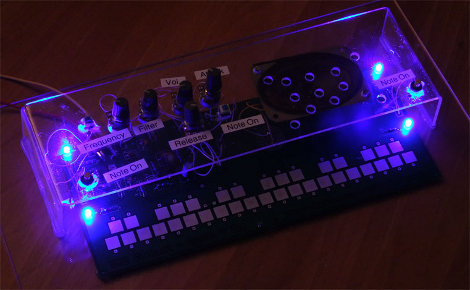
Inspired by the memory of a childhood electronics kit, [Frank] decided to make a new 555 Synthesizer and enter it into the 555 contest. [Frank’s] remake is played with a stylus, and sports an attack and release envelope circuit, housed in a quick but effective acrylic case.
Using a single 555 timer, a hand full of capacitors, two transistors, and a healthy dose of resistors and potentiometers, the sound is quite impressive thanks to optional filtering, enveloping, and a lot of fine tuning. Full schematics, bill of materials, formulas, and board files are all available along with sources for some of the more specialized potentiometers.
Join us after the break for a ~13 minute long video, which is pretty cool, as it shows the device from prototype, and does some fast forward action though to the final product pictured above, though if you just want a demo of the 555 synth fast forward to 10:44
[youtube=http://www.youtube.com/watch?v=GUx0FtTQ460&w=450]















looks like lots of fun :)
nice build style!
looks pretty well doc’d. good work fella.
oooooh, what a lucky man he was….
So basically he made a fancy stylophone
I didn’t see much description regarding the volume envelope circuitry, and thats the part that I’m the least comfortable with; can someone explain exactly how that part works? Are both Q1 and Q2 involved in the envelope portion? What are S2/S3/S4 switching?
Also, assuming I wanted to replicate just the envelop circuitry to be used with any input signal, what modifications would I need to do? Isolate with an optocoupler?
@SDC
It took me a minute, but now I get it. I literally laughed out loud. Great song too.
greensleeves ftw.
I’ve updated the website a bit. To quote it:
The oscillator part is a 555 with a standard oscillator circuit. T2 and C1 is for the lowpass filter. T3 is for the volume and T4 and T5, with Q1 and the rest around Q1, is for the volume envelope with attack and release. Q2 is a standard class A amplifier for the speaker. S2, S3 and S4 are the “Note On” buttons in the video and the picture. Two of it are pushbuttons on the left and the right side and one is a toggle button, for constant signal generation.
The volume envelope works like this: when all “Note on” switches are off, C3 is charged by T5 and Q1 is conducting, which inhibits Q2. If you turn on one of the three switches, C3 is discharged and Q1 is not conducting any more, so Q2 is conducting and amplifying the sound. With T4 and T5 you can change the time constants how long it takes to charge and discharge C3.
I hope this helps. You don’t need an optocoupler, if you don’t have ground loops, e.g. if you have the sound generator and the envelope circuit and amplifier on the same board.
But as written on the website: I’m not an analog expert, I’m sure the circuit with the 2 transistors could be done much better.
Thanks Frank, that clears it up a lot. Is there no coupling of the signal path with the volume envelope? You mentioned that the volume pot changes the filter, on further reflection you must mean the low-pass filter but when I first read it I guess I assumed that the envelope generation was affected, too.
I also don’t know why I jumped straight to an optocoupler when a simple opamp in unity gain mode would isolate just as well, I guess because I’m looking at adapting that section of your circuit for a stand-alone volume envelope generator, and want the inputs/outputs well isolated.
Anyways, thanks a lot for the writeup and description, its quite nice, and your explanation really helped me out.
Yes, I think it’s both affected, because I guess it would need some more transistors to decouple it.
After some searching, this looks like a much better, and full ADSR envelope, circuit:
http://www.uni-bonn.de/~uzs159/adsr.html
(there are nice other projects on the site http://www.uni-bonn.de/~uzs159/ )
With some op-amps it should be possible to create something similar or better, without transistors (but maybe some additional diodes), but not for me, because I’m just a programmer, not an analog circuit designer :-)
you should put metal tape on the fingers of a glove(attatched to the alligator clip)so you can touch it w/ your fingers! =3